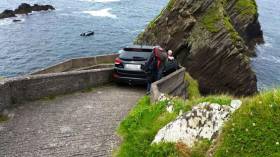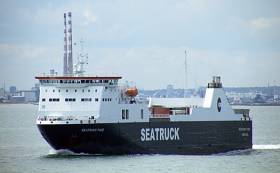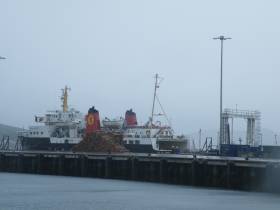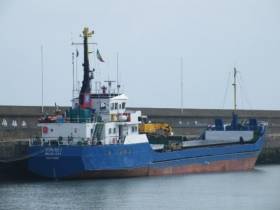Displaying items by tag: Ferry news
Unfortunate Motorist Blocks Path To Blasket Islands Ferry Pier
#FerryNews - Ferries from Dunquin to the Blasket Islands were cancelled this morning – not on account of the weather, but a motorist who managed to wedge their car on a tight bend on the pedestrian-only path to the pier.
Blasket Island Ferries shared a photo of the unfortunate vehicular mishap on their Facebook page, where it's since gone viral with almost 8,000 likes.
According to TheJournal.ie, the driver in question was forced to spend the night in his motor, which was eventually removed with the help of a local tractor at lunchtime today.
"It would be the busiest week of the year for us, so plenty of people were a little annoyed at not being able to catch the ferry this morning," as Sibéal Ní Lubhaing of the ferry company told BreakingNews.ie, which has more on the story HERE.
#AwardFinalist - Seatruck Ferries, the Irish Sea's only operator dedicated to ro-ro freight, have been selected as a finalist for 'Company of the Year' at next month’s 2016 Lloyd's List Global Awards, writes Jehan Ashmore.
The freight company, part of the Danish owned Clipper Group, has a network of three routes: Dublin-Liverpool, Dublin-Heysham and Warrenpoint-Heysham. The last route linking Northern Ireland and England is where Seatruck began operations twenty years ago in 1996.
The Lloyd's List Global Awards, are widely regarded as the ‘Oscars’ of the worldwide shipping industry, which are to take place in London at the National Maritime Museum, Greenwich on the 28th September.
Also nominated for the Company of the Year award are CMA CGM, Hapag-Lloyd, Maersk Line, Pyxis Tankers and Waterfront Shipping Company.
In the first 6 months of 2016, Seatruck Ferries recorded Irish Sea freight growth of over just 18%, three times the market level of 5.8%. Strongest growth was achieved on the central corridor between Liverpool – Dublin, where in March was introduced a larger third ‘P’ Class freight vessel, Clipper Pace (1,850 lane metres).
Repaired Scottish Ferry Returns to Islay Service
#FerryReturns - Scottish ferry operator Caledonian MacBrayne (CalMac) has confirmed repairs to MV Hebridean Isles have been completed following a collision at Kennacraig, Kintyre last month.
The 494 passenger /68 car/10 lorry capacity ferry had undergone repairs to the bow at the Garvel Dry Dock, Greenock on the Clyde. The ferry since yesterday returned to Kennacraig-Islay service.
Plans to operate Islay running mate, MV Finlaggan overnight to accommodate freight traffic will continue for the rest of the week on a 24 hour service until next Saturday, August 13th.
The return of Hebridean Isles has not required the deployment of MV Isle of Arran as previously reported on Afloat.ie and the vessel remains on her usual route to and from Ardrossan to Arran.
CalMac to Redeploy Arran Ferry to Increase Islay Capacity
#ArranRedeployed - Scottish ferry operator, Caledonian MacBrayne is to redeploy a vessel from the Isle of Arran route to Islay and moving another to 24 hour working to increase capacity on the route.
The withdrawal of the Islay serving MV Hebridean Isles for urgent repairs reported last week here on Afloat.ie has left the Southern Hebrides island working with a single vessel over the last two weeks.
To ease disruption on the route, CalMac has now familiarised a new crew to operate the MV Finlaggan and the vessel will run an overnight freight service between Islay and Kennacraig, as well as her normal daytime timetable. Large vehicles such as caravans and camper vans will also be moved on to the overnight sailing to free up space during the day.
"We appreciate the inconvenience this ongoing disruption is causing and looked at all the options to address the issues the island is experiencing. This is particularly busy week,with the Islay Show taking place on Thursday, so we need to use the available fleet resources we have at our disposal to meet demand. Unfortunately, this means moving the the MV Isle of Arran off her normal Arran route. We realise this is not ideal, but hope the community on Arran understand the reasons behind this decision and we appreciate their cooperation," said CalMac's director of operations, Drew Collier.
"We feel this is the best solution we have to meet the demands we are currently experiencing across the network."
The MV Isle of Arran will sail the Kennacraig to Islay route begining from tomorrow, Tuesday and also Wednesday and Thursday of this week.
"We will be monitoring this on a daily basis and hopefully the redeployment of the Isle of Arran will be very short term only. Our technical team is working hard to get the Hebridean Isles back in service as quickly as possible and we appreciate people's patience and continuing understanding," added Drew.
Afloat adds while Isle of Arran is redeployed, her Arran fleetmate, M.V. Caledonian Isles will continue to operate sailings as normal on the Ardrossan-Brodick route
Disruption to Scottish Service As Ferry Collides With Pier
#Disruption - A Scottish ferry that serves the Southern Hebrides island of Islay had a collision with a pier on the mainland near the end of last month, writes Jehan Ashmore.
The incident involved CalMac’s Hebridean Isles at Kennacraig Pier, Kintyre, this led to the vessel been withdrawn from Islay (Port Ellen /Port Askaig) routes. Hebridean Isles, currently remains under repair with work to the bow, at the Garvel James Watt Dock, Greenock, on the Clyde, operated by the Forth Group.
Ferry services between Kennacraig-Islay have been reduced to one ferry operated by Finlaggan. The disruption during the high-season, has led to CalMac chartering a cargoship with vehicle bow-loading capability, the Red Princess.
To ease congestion, Red Princess, a former Mediterranean ferry, normally used to carry round timber, is been used to alleviate the backlog of vehicle traffic from Kennacraig to Islay and back while Hebridean Isles is being repaired.
Passengers will not be taken on the Red Princess, however they will be transferred to Finlaggen on the Kennacraig-Islay routes.
Other routes that Hebridean Isles served to the Southern Hebrides (including Colonsay) based out of Oban have been cancelled, however those booked are been transferred to alternative sailings.
Port Ellen, on the southern coast of Islay, is where Kintyre Express operate a service to Ballycastle, Co. Antrim as previously reported on Afloat.ie, see Port Snapshot: Campbeltown.
Port Snapshot: Campbeltown's Kintyre Links Continue With Ireland As Cruise Tallship Calls
#PortSnapShot – Campbeltown, Scotland, almost at the tip of the Mull of Kintyre and a mere 19 km/12 miles from Northern Ireland, is where the impressive cruise tallship, Sea Cloud II is visiting today, writes Jehan Ashmore.
The 5-star ultra-luxury Sea Cloud II having made an overnight call to Dublin Port that ended yesterday. This evening she heads into the North Channel on the short passage to Belfast Harbour.
Guests of the Sea Cloud Cruises ‘windjammer’, is docked alongside the New Pier at Caledonian MacBrayne’s (CalMac) ferry terminal. This season marks the first year of the ‘permanent’ designated Ardrossan-Campbeltown service, following a three-year summer operated pilot service as part of CalMac's extensive route network of the Clyde and Western Isles.
Sea Cloud II's presents a majestic appearance given her three masts in which the main mast towers 57m /187ft, however, a 3,849 gross tonnage is not much larger than the local CalMac ferry, Isle of Arran of 3,296 respectively. The thrice-weekly operated ferry is not today in port which is home to a trawler fleet.
Asides the seasonal Forth of Clyde ferry service to and from Ardrossan, Campbeltown’s second ferry link consolidates the Irish connection. At the town’s marina is where the ‘passenger’-only RIB ferry to Ballycastle, Co. Antrim is operated by Kintyre Express They also have a Ballycastle service to Port Ellen on Islay.
Prior to this Ireland-Scotland link, was the Argyle & Antrim Steamship Co. that also ran between Campbeltown and Ballycastle. The short-lived three-year (1997-2000) summer-only route was served by Claymore, having been sold by CalMac to the company, a subsidiary of Sea Containers (Scotland) Ltd. In winter she acted as overhaul relief vessel for CalMac when under charter.
On a notable occasion, Claymore left Scottish waters, when chartered during the visit of USS John F. Kennedy (CV-67) as the giant 82,000 tonnes aircraft carrier anchored off Dun Laoghaire Harbour, just over two decades in July 1996. A public lottery was held for thousands to visit the Dublin Bay naval visitor by boarding Claymore and other ‘tender’ vessels. This was during the backdrop of Jean Kennedy-Smith's tenure as US Ambassador to Ireland, in the early days of the northern 'peace process'.
Asides the Ardrossan ferry, Campbeltown exports round timber (logs) as seen above at the New Pier Quay, where Sea Cloud II currently occupies this berth. Short-sea coasters on occasions call to the harbour to load timber to Irish ports, among them Rosslare Harbour as previously reported on Afloat.ie.
Last but not least, P.S. Waverley, the world’s last sea-going paddle-steamer, in which among her owners included Caledonian MacBrayne until withdrawn in 1973. Two years later she was sold for preservation and is less than two months to celebrating her 70th anniversary, having been launched on the Clyde at a Glasgow yard in 1946.
She is operated by Waverley Steam Navigation Co. Ltd. During seven decades the veteran vessel has carried over 5 million passengers from over 60 ports around the UK. This summer she made an Antrim Coast Cruise off Redbay. Stormforce RIBS used by Kintyre Express are manufactured by Red Bay Boats in Cushendall that overlooks the bay.
Waverley made her Irish debut in 1984 along Leinster's eastern seaboard. Over subsequent calls, she has visited Dundalk, Dublin, Dun Laoghaire, Wicklow, Arklow and as far south to Rosslare Harbour. The paddle-steamer excursions also included transitting Dalkey Sound.
Redevelopment of CalMac Ferry Terminal on Isle of Arran
#Redevelopment - Caledonian MacBrayne (CalMac) the Scottish Government funded publically owned ferry network, which was awarded an EU tendering process to continue running Clyde and Western Isles services, is involved in redeveloping a ferryport, writes Jehan Ashmore.
On one of CalMac's Forth of Clyde routes, Ardrossan-Brodick, Isle of Arran, is where construction is underway at a ferryport. The redevelopment is the construction of a new double-berth and ferry terminal in Brodick which is progressing at the island’s main town on the east coast. On a related note the Irish port of Wicklow is connected in the terminal project, through a regular caller (click report here)
The ferry to Arran, is the most southerly of the Scottish Western Isles services, though a summer-only mainland connection also links Ardrossan, in Ayrshire and Campbeltown on the Mull of Kintyre, Argyle.
As part of the overall redevelopment at Brodick Ferry Terminal a Passenger Access System (PAS) is scheduled to be commissioned in summer 2017 before the new facility is completed and handed over to CalMac Ferries Ltd in August 2017.
In a further boost of confidence for the route and notably to serve the islanders and tourists alike, is the addition of new tonnage which is also to arrive from Spring 2018.
A pair of 100m long newbuild ferries, each with a 1,000 passenger capacity and 127 cars/16 HGV's (or combination) are on order for construction to Fergusan Marine Engineering Ltd (FMEL) on the Clyde.
The £97m contract is from Caledonian Maritime Assets Ltd (CMAL) which owns the 31 strong fleet, as well to properties at piers and harbours at more than 26 locations throughout Scotland.
The newbuilds are earmarked for the Ardrossan-Brodick and the Uig Triangle routes. A final decision, however on deployment rests with the ferry operator and will be informed by further analysis of demand on all major routes.
The more environmentally friendly newbuilds are to be ‘dual-fuel’ powered through use of liquefied natural gas (LNG) and marine diesel.
Wicklow Regular Involved in Scottish Ferryport Redevelopment
#CargoTerminal - A Wicklow Port regular, cargoship Burhou I, has been involved in assisting construction of a new ferryport, away from routine ‘bread and butter’ cargoes such as round timber, writes Jehan Ashmore.
Among the various work related vessels at CalMac’s ferry terminal redevelopment at Brodick on the Isle of Arran, has involved the 647 tonnes general cargoship coaster, operated by Great Glen Shipping.
The veteran vessel dating from 1978, arrived loaded with primary rock armour for the project to be completed in summer 2017. The cargo was loaded at Furnace, Argyll across the Forth of Clyde.
Burhou 1 which normally discharges round timber (logs) cargoes from Scotland to Wicklow, had in March been detained by Port State Control for a single technical deficiency. After shifting berths to the East Pier, repairs were made to the 58m long, Belize City registered coaster. This was to satisfy PSC clearance prior to granting departure.
This evening, Burhou 1 is heading through the North Channel bound for Lochaline, Scotland, after a call to Passage West, Cork Harbour. This is a privately owned wharf, which regularly sees timber and scrap-metal cargoes as reported by Afloat back in 2011 that reflected on old Irish shipping firms.
Heading also northbound is another timber trader, Scot Ranger (1997/2,260gt) registered at Inverness, which too called to Wicklow. Shipowners, Scot Line, are regular clients of the east coast port where the 86m vessel arrived from Newport, south Wales to berth at Packet Quay.
Both vessels this evening are abreast of each other off the Co. Antrim coast.
One of eight in the fleet, Scot Ranger, is regularly engaged in supplying Swedish packaged timber products from Varberg to dedicated terminals in the UK and to Irish ports. Following the call to Wicklow, last night the 86m vessel anchored off Dublin Bay awaiting orders. She is now heading to Varberg.
Isle of Man Government Vote to Buy a Bit of Liverpool
#LiverpoolTerminal - The Isle of Government, Tynwald has voted to acquire a site in Liverpool for a new ferry terminal writes IOM Today.
The Manx Government are also to continue talks with the island's sole operator, the Isle of Man Steam Packet over a new sea services deal.
But following a raft of amendments, and amendments of amendments, the near-four hour debate ended in farce as it became clear that the court was not sure what it had voted for.
New Tynwald president Steve Rodan remarked: ‘You can look up in Hansard what we have just voted on if you are unclear!’
During the debate, the Steam Packet was criticised for its ‘threats and blackmail tactics’ and its motive in pursuing an early deal questioned, with a number of MHKs claiming a distressed fund manager called Anchorage which has a 31 per cent shareholding was just after making a quick profit.
There was no such questioning of the role of the Peel Group from whom a 236-year lease on Princes Half Tide Dock is to be purchased for a new ferry terminal for a price of up to £3.5m.
Indeed all Tynwald members appeared to support the move to buy the site despite no clear explanation being given as to why the taxpayer is to get involved at all, given that Peel had originally indicated it would fund the facility in its entirety – if it could get a guarantee of long-term commitment to the route.
Infrastructure Minister Phil Gawne said it was ‘an opportunity we would not want to miss’. He said any agreement to buy the site would provide for it to be returned to the owner at no cost to government if the development didn’t subsequently go ahead.
Leonard Singer (Ramsey) said the purchase of the site would mean we would control both ends of the route.
There will be an open tender for the design and build contract for the ferry terminal, the £25m cost funded by the developer. The DoI report says no work would begin ‘until a suitable agreement has been reached for its long-term use by IOMSPCo’.
The IOM Today has much more on the story here.
#ProfitsSink - Dun Laoghaire Harbour will welcome tomorrow a mid-season cruise caller, this will be against the backdrop of losses by the port company last year, writes Jehan Ashmore.
Celebrity Silhouette of 122,400 gross tonnage, and a combined passenger and crew total of 4,000, is to make a return 'anchorage' visit off the south Dublin Bay harbour following a debut call in 2015. A proposed new cruise liner berth submitted by Dun Laoghaire Harbour Company is still awaiting a decision by an Bord Pleanala.
Accounts for the Dun Laoghaire Harbour Company reveal a €6.3 million loss reports The Times, after Stena Line officially confirmed that is was to withdraw HSS services ‘permanently’ from the port to Holyhead last year. Not to be confused Afloat adds with the final season of HSS Stena Explorer sailings that actually took place the previous year when the fast-ferry ceased in September 2014.
The company had previously said that it was focused on finding a new operator to continue the long history of ferry links between Dun Laoghaire and Britain.
In its latest annual report it said that while it still hoped to resume some ferry services to Holyhead, it was also looking at new uses for the St Michael’s Pier terminal building.
When Stena Line ceased to operate the route in February 2015 seven expressions of interest were received as previously reported on Afloat.ie.
Also reported on Afloat was the dismantling and removal of the former Stena HSS berth-linkspan and associated passenger gangway structure. Since that report, Afloat has learnt that the custom-built linkspan at St. Micheal’s Pier has been removed on site and not taken away by barge.
The process of removing HSS related port infrastructure are scheduled to take up to next month. DLHC added that harbour facilities will only become available for use by a potential new ferry operator but not until 2017.


































































